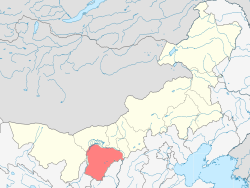This article needs additional citations for verification. (December 2018) |
Ordos
| |
|---|---|
 View of Dongsheng District | |
 Location of Ordos City jurisdiction in Inner Mongolia (orange) | |
| Coordinates (Genghis Khan Plaza, Kangbashi): 39°36′14″N 109°47′06″E / 39.604°N 109.785°E | |
| Country | People's Republic of China |
| Region | Inner Mongolia |
| Municipal seat | Kangbashi District |
| Area | |
| • Prefecture-level city | 86,752 km2 (33,495 sq mi) |
| • Urban (2017)[1] | 2,526.5 km2 (975.5 sq mi) |
| • Metro | 5,859.8 km2 (2,262.5 sq mi) |
| Elevation | 1,305 m (4,281 ft) |
| Highest elevation | 2,149 m (7,051 ft) |
| Lowest elevation | 850 m (2,790 ft) |
| Population (2020 census[2]) | |
| • Prefecture-level city | 2,153,638 |
| • Density | 25/km2 (64/sq mi) |
| • Urban | 693,038 |
| • Urban density | 270/km2 (710/sq mi) |
| • Metro | 366,779 |
| • Metro density | 63/km2 (160/sq mi) |
| GDP[3] | |
| • Prefecture-level city | CN¥ 422.6 billion US$ 67.9 billion |
| • Per capita | CN¥ 207,163 US$ 33,261 |
| Time zone | UTC+8 (China Standard) |
| Postal code | 017000 |
| ISO 3166 code | CN-NM-06 |
| Licence plate prefixes | 蒙K |
| Administrative division code | 150600 |
| Website | www |
| Ordos City | |||||||||||||||||
|---|---|---|---|---|---|---|---|---|---|---|---|---|---|---|---|---|---|
| Chinese name | |||||||||||||||||
| Simplified Chinese | 鄂尔多斯市 | ||||||||||||||||
| Traditional Chinese | 鄂爾多斯市 | ||||||||||||||||
| |||||||||||||||||
| Mongolian name | |||||||||||||||||
| Mongolian Cyrillic | Ордос хот | ||||||||||||||||
| Mongolian script | ᠣᠷᠳᠣᠰ ᠬᠣᠲᠠ | ||||||||||||||||
| |||||||||||||||||
Ordos,[a] also known as Ih Ju, is one of the twelve major subdivisions of Inner Mongolia, China. It lies within the Ordos Plateau of the Yellow River. Although mainly rural, Ordos is administered as a prefecture-level city. Its population was 2,153,638 as of the 2020 census, and its built-up (or metro) area made up of Ejin Horo Banner and Kangbashi District was home to 366,779 inhabitants, as Dongsheng District (574,442 inhabitants) is not a conurbation yet.[2]
Ordos is known for its recently undertaken large scale government projects including most prominently the new Kangbashi District, an urban district planned as a massive civic mall with abundant monuments, cultural institutions and other showpiece architecture. It was the venue for the 2012 Miss World Final.[4]
When it was newly built, the streets of the new Kangbashi district did not have much activity, and the district was frequently described as a "ghost city" by several Western media outlets.[5] However in 2017, writing in a Forbes article, Wade Shepard said that it became increasingly difficult to apply this label as the city's population had surged to 153,000, which was an increase from 30,000 in 2009.[6]
- ^ a b Ministry of Housing and Urban-Rural Development, ed. (2019). China Urban Construction Statistical Yearbook 2017. Beijing: China Statistics Press. p. 46. Retrieved 11 January 2020.
- ^ a b "China: Inner Mongolia (Prefectures, Leagues, Cities, Districts, Banners and Counties) - Population Statistics, Charts and Map".
- ^ 内蒙古自治区统计局、国家统计局内蒙古调查总队 (2016). 《内蒙古统计年鉴-2016》. 中国统计出版社. ISBN 978-7-5037-7901-5.
- ^ Sheehan, Matt (5 April 2015). "Signs of Life In China's Gleaming 'Ghost City' Of Ordos". Huffington Post. Retrieved 17 July 2018.
- ^ Day, Peter (17 March 2012). "Ordos: The biggest ghost town in China". BBC News. Retrieved 15 February 2022.
- ^ Shepard, Wade. "China's Most Infamous 'Ghost City' Is Rising From The Desert". Forbes. Retrieved 24 August 2018.
Cite error: There are <ref group=lower-alpha> tags or {{efn}} templates on this page, but the references will not show without a {{reflist|group=lower-alpha}} template or {{notelist}} template (see the help page).